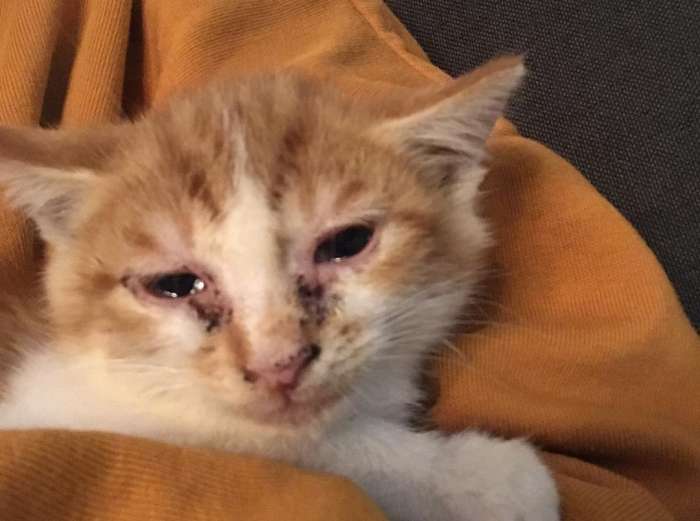Cats, like humans, can catch colds, leading to discomfort and health issues. As a responsible cat owner, it’s crucial to recognize the symptoms of a cold in your feline friend and know how to provide effective treatment. In this article, we will explore practical methods to help your cat recover quickly from a cold.

1. Understanding Cat Colds
What Is a Cat Cold?
A cat cold, often referred to as upper respiratory infection (URI), is typically caused by viruses, such as feline herpesvirus or calicivirus. Symptoms can vary but commonly include sneezing, nasal congestion, runny eyes, and lethargy.
Symptoms of a Cat Cold
Recognizing the symptoms early can help you take appropriate action:
- Sneezing: Frequent sneezing can indicate nasal congestion.
- Runny Nose and Eyes: Watery discharge may accompany a cold.
- Coughing: Some cats may cough as a response to irritation.
- Loss of Appetite: A decreased desire to eat or drink is a common sign.
2. Providing Comfort and Care
Create a Comfortable Environment
When your cat is feeling under the weather, a comfortable environment is essential:
- Warm and Cozy Space: Provide a warm, quiet space for your cat to rest. Blankets or a soft bed can help.
- Reduce Stress: Limit loud noises and disturbances that may stress your cat.
Ensure Hydration
Hydration is crucial for recovery:
- Fresh Water: Always provide access to fresh water. Cats may prefer drinking from a fountain, as moving water can be more appealing.
- Hydrating Foods: Offer wet cat food to help keep your cat hydrated.
3. Nutritional Support
Feeding a Nutritious Diet
A balanced diet can aid in recovery:
- High-Quality Cat Food: Ensure your cat is eating high-quality food rich in protein and nutrients.
- Consider Appetite Stimulants: If your cat is not eating, consult your veterinarian about appetite stimulants or special diets.
Supplementation
Discuss the use of supplements with your vet:
- Vitamins and Minerals: Supplements can support your cat’s immune system, especially if they are not eating well.
4. Home Remedies for Cat Colds
Steam Therapy
Steam therapy can help relieve nasal congestion:
- Humidify the Air: Running a hot shower and letting your cat sit in the steamy bathroom for a few minutes can help open nasal passages.
Warm Compress
A warm compress can provide relief:
- Applying a Compress: Use a warm, damp cloth to gently wipe your cat’s eyes and nose. This can help clear any discharge and provide comfort.
5. Veterinary Consultation
When to See the Vet
Not all colds can be treated at home:
- Persistent Symptoms: If your cat’s symptoms persist for more than a few days, or if they worsen, consult your veterinarian.
- Severe Symptoms: Seek immediate veterinary care if your cat exhibits severe symptoms, such as difficulty breathing, high fever, or lethargy.
Diagnostic Tests
Your vet may recommend tests:
- Blood Work: To rule out other underlying conditions.
- Viral Testing: To identify the specific virus causing the cold.
6. Medications and Treatments
Antiviral Medications
In some cases, antiviral medications may be necessary:
- Prescription Options: Your veterinarian may prescribe antiviral medications if a specific virus is identified.
Decongestants
Decongestants can provide relief:
- Consult Your Vet: Do not administer over-the-counter medications without veterinary guidance, as some can be harmful to cats.
7. Preventing Future Colds
Boosting Immunity
Strengthening your cat’s immune system is crucial:
- Regular Vet Visits: Keep up with routine veterinary check-ups and vaccinations.
- Healthy Diet: Ensure your cat receives a balanced diet to support overall health.
Reducing Stress
Stress can weaken the immune system:
- Safe Spaces: Provide your cat with safe spaces where they can retreat when feeling overwhelmed.
- Interactive Play: Regular playtime can help alleviate stress and promote a healthy lifestyle.
8. Environmental Considerations
Clean Living Space
Maintaining a clean environment is essential for health:
- Regular Cleaning: Frequently clean your cat’s bedding, litter box, and living areas to reduce the risk of infections.
- Air Quality: Ensure good ventilation in your home to keep the air fresh and reduce allergens.
Avoiding Contact with Infected Animals
Preventing exposure to other sick animals is key:
- Limit Outdoor Access: If possible, keep your cat indoors during cold and flu seasons.
- Monitor Playdates: If your cat interacts with other animals, ensure they are healthy to reduce the risk of infection.
9. Conclusion
Treating a cold in your cat requires a combination of comfort, care, and veterinary guidance. By understanding the symptoms and implementing effective treatments, you can help your cat recover quickly and maintain their health. Always consult your veterinarian for tailored advice and ensure your cat’s well-being.

Comments (0)